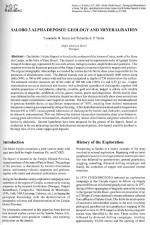Добрый день, Коллеги. Важное сообщение, просьба принять участие. Музей Ферсмана ищет помощь для реставрационных работ в помещении. Подробности по ссылке
Salobo 3 Alpha deposit: geology and mineralisation
The Salobo 3 Alpha Deposit is found in the southeast of the Amazon Craton, north of the Serra dos Carajas, in the State of Para, Brazil. The deposit is contained in supracrustal rocks of Igarape Salobo Group of Archean age, represented by iron-rich schists, metagreywackes, amphibolites and quartzites. This sequence overlies the basement gneisses of the Xingu Complex composed of partially migmatized gneisses. The original stratigraphic relationships are masked by intense ductile-brittle shear zones responsible for the generation of allochthonous rocks. The deposit extends over an area of approximately 4000 metres along strike (NW), is 100 to 600 metres wide and has been recognised to depths of 750 metres below the surface. The estimated mineral resources are of the order of 789 Mt with 0,96% Cu and 0,52 g/t Au. Copper mineralization occurs as chalcocite and bomite, with subordinate quantities of chalcopyrite, together with variable proportions of molybdenite, cobaltite, covellite, gold and silver, lodged in schists with variable proportions of magnetite, amphibole, olivine, garnet, biotite, quartz and piagioclase. Brittle-ductile shear zone deformation has resulted in lenticular shaped ore shoots that characteristically show close associations between copper mineralization and magnetite contents. The host rocks were progressively metamorphosed to pyroxene hornfels facies, at equilibrium temperatures of 750°C, resulting from sinistral transcurrent transpressive shearing accompanied by oblique thrusting. A first hydrothermal event developed at temperatures between 650 to 550°C causing partial substitution of chalcopyrite by bornite and chalcocite, accompanied by intense K-metasomatism. This was followed by sinistral transcurrent transtensive shear zone formation, causing green schist facies metasomatism, characterized by intense chloritization and partial substitution of bornite by chalcocite. Several hypotheses have been proposed for the genesis of the deposit. Based on similarities in the ore mineralogy and the hydrothermal alteration pattern, this deposit could be ascribed to the large class of iron oxide copper-gold deposits.




